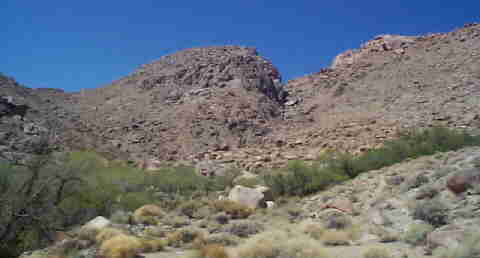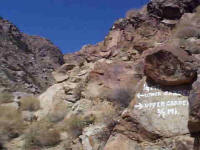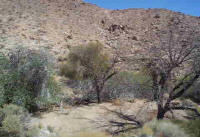Trona on the Web: Indian Joe's Springs

Bill Graffunder sent me some pictures from his recent visit to Indian Joe's Springs.
I can tell you what I remember of Indian Joe's, about half way -- when there was water, there were several little ponds with pollywogs and small frogs. I have no idea how they survived the dry spell. Somewhere along the canyon trail was a black walnut tree. I think it was after the frog ponds.
 |
 |
| Photos by Bill Graffunder March 31, 2002 | |
During one of my early pre-teen visits I can remember there being a shack in the canyon. I can also remember hear that someone burned it to the ground shortly after that.
In the first area, probably what is now called the lower gardens, there was a clearing that had rocky cliffs on one side and on the other were huge fig trees that were growing near a gully. There must have been several hundred initials cut into the bark of the fig trees. There was an old apple tree near the middle of the clearing I cannot imagine that it has still survived and somewhere there was a pear tree but I cannot remember where. At one time this clearing was fenced in with a rail fencing made from iron pipe. I am sure it was used as coral for livestock.
As you followed the gully from the figs trees to a little further up the canyon there was a blackberry vine patch that were so grown over that it was almost impossible to pick them or to proceed any further up the gully in that direction without going up and around. In that same area were grape vines. And past the berry patch there was a small spring shaded by the trees with mint, watercress and wild celery growing in the bog. I imagine this is what is now called the upper gardens.
I used to walk or catch a ride to "The Point" and then hike the rest of the way in the cool of a spring morning with 2 empty Crisco cans in my backpack to fill full of figs, berries, mint and watercress.
When my mother would allow it I would spend the night. That always required that I bring someone with me so it didn't happen all that often. I can remember one time waking up in the middle of the night and finding a kangaroo rat eating the cornbread I made over the campfire the night before.
As a kid who grew up in Trona in the 40's and 50's Indian Joe's was my favorite area. It was an opportunity to eat fresh picked fruit and seemed like the Garden of Eden. I hope that the things that made it seem so wonderful to me are still there.
It was very common to see burro droppings and places where the burros had smelled water and had dug out holes in the sand for the water to seep into. I can understand the value of the burro in the desert. It wasn't at all that uncommon to see the burros grazing on the hillsides around Indian Joe's especially in the spring. Or was it uncommon to hear the cry of a bobcat somewhere in the hills. You could always be sure you would hear coyotes during a nights visit.
The first white men to visit Indian Joe's Spring were probably the Jayhawkers in 1850 and the water there may have saved their lives. In 1873 John Searles and his brother drove the Indians who lived there the from the canyon and built a home and other buildings and planted a garden and an orchard. it wasn't until 1904 that Indian Joe Paterson and his family returned to the canyon. After the Indians left nature tried to reclaim the canyon. I suspect though, that the fig trees that are now over 100 years old and some the other plants that John Searles brought there, have changed the canyon forever.
Indian Joe's was given to the Audubon Society and is now managed by the State of California Parks Service.
The Indian Joe's Springs are feed from the winter snows from the Argus Range. In October of 1960 I hiked past Indian Joe's, with the goal of reaching the top of Argus Peak. I ignored the "Keep Out" signs of the US Navy and climbed until I almost reached the top. I ended up on the back side of the Argus Range and I could tell that I had not been the first person there because of the pine tree stumps that had been cut with what looked like a saw, who knows when. From the Ridgecrest side of Argus Range climbing to the top of Argus Peak would have been much easier, even if much further. Be sure to get permission from the Navy before you try this and always make sure you have plenty of water when hiking in the desert.
There on the Ridgecrest side of Argus Range, is where I saw three wild horses. One was just a colt. Up until then I had no idea there were wild horses in the area. I watch them for the longest time, while wishing I had brought my camera. And then finally one of them spotted me and off they ran across the high plane they were on. By then it was getting too dark to make the top of Argus Peak and I had to turn around. It was dark long before I reached the bottom I won't go into any of the details of all the risks I took traveling down an unfamiliar mountainside in the dark. When I got home I found out my mother had sent the sheriff out to find me. It was a short search. Because, to my surprise, he was able to find my footprints at the base of Argus Range leading in both directions.